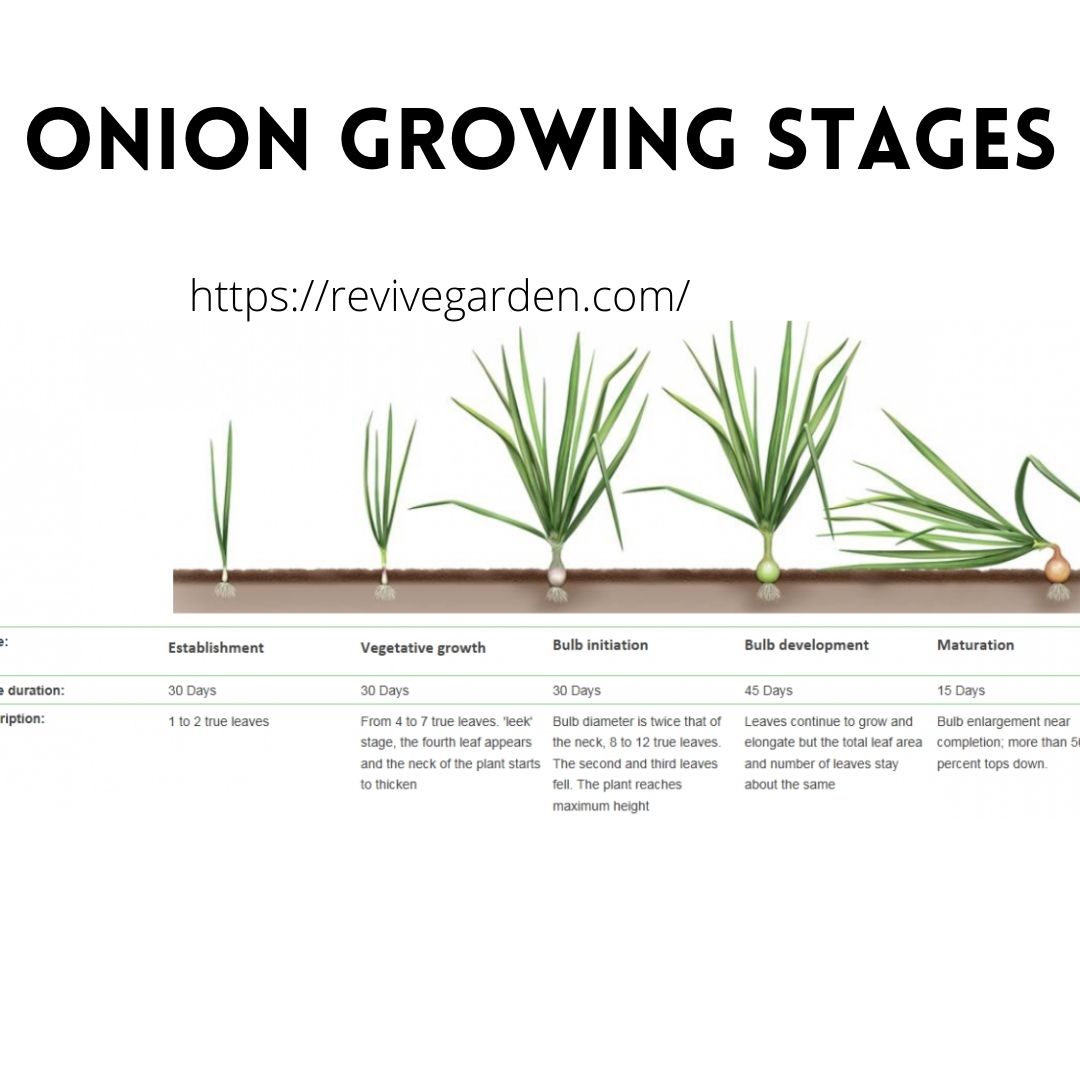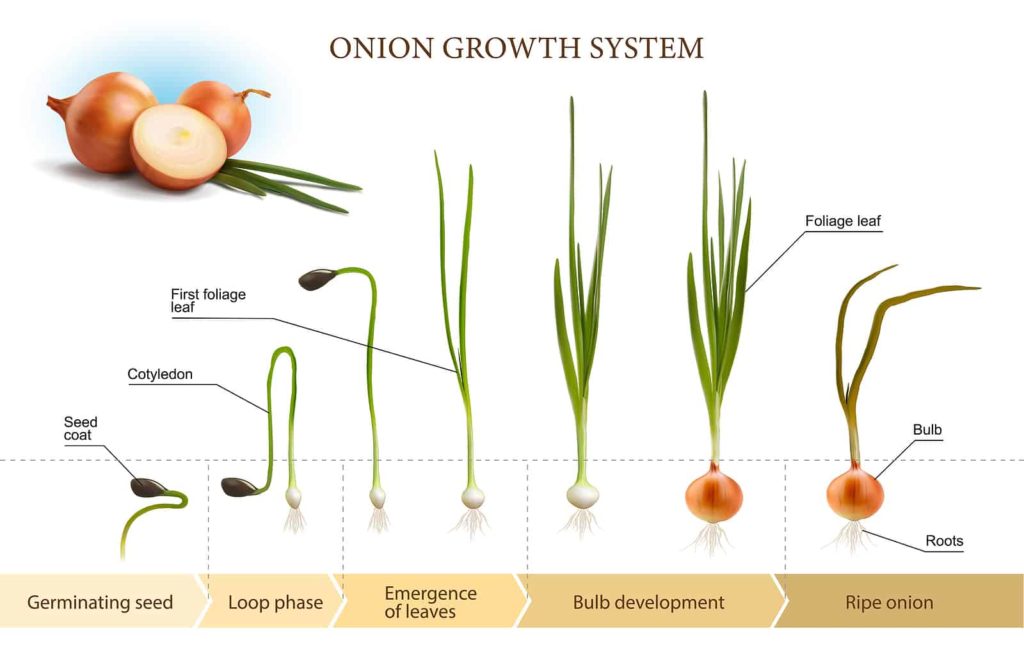The Life Cycle of Onions: Understanding the Growth Stages
Onions, a staple ingredient in many cuisines, undergo a fascinating transformation from seed to maturity. Understanding the different growth stages of onions is crucial for optimal growth and maximizing yields. The life cycle of onions can be broadly divided into five stages: seed germination, seedling establishment, bulbing, maturation, and harvesting. During the seed germination stage, onions require consistent moisture and temperatures between 65°F to 75°F (18°C to 24°C) to sprout. Once germinated, the seedlings need adequate light and water to establish a strong root system. As the plants grow, they begin to form bulbs, which is the most critical stage of onion growth. During this stage, onions require careful management of water, nutrients, and pest control to prevent damage. Finally, the onions mature and are ready for harvesting, typically within 3 to 4 months of planting. By understanding these growth stages, growers can provide the necessary conditions for onions to thrive, ultimately leading to a successful harvest. This knowledge is essential to answer the question of how fast does onion grow, as it allows growers to optimize their growing conditions and techniques.
Factors Affecting Onion Growth: Climate, Soil, and Light
Onion growth is significantly influenced by various environmental factors, including climate, soil quality, and light exposure. Understanding these factors is crucial to create an ideal environment for onions to thrive. Climate plays a vital role in onion growth, with optimal temperatures ranging from 65°F to 75°F (18°C to 24°C) during the day and no lower than 55°F (13°C) at night. Onions also require adequate moisture, with consistent rainfall or irrigation essential for healthy growth. Soil quality is another critical factor, with onions preferring well-draining, fertile soil with a pH between 6.0 and 7.0. Light exposure is also essential, with onions requiring at least 6 hours of direct sunlight per day. By understanding these factors, growers can create an ideal environment for onions to grow, ultimately affecting how fast does onion grow. For instance, onions grown in regions with mild winters and cool summers tend to grow faster than those grown in areas with extreme temperatures. By optimizing these factors, growers can promote healthy growth and maximize yields.
How to Create an Ideal Environment for Onion Growth
Creating an ideal environment for onion growth is crucial for optimal development and maximum yields. To achieve this, growers should focus on three key areas: soil preparation, irrigation, and pest management. Soil preparation is essential, as onions prefer well-draining, fertile soil with a pH between 6.0 and 7.0. Adding organic matter such as compost or manure can improve soil structure and fertility, ultimately promoting healthy growth. Irrigation is also critical, as onions require consistent moisture, especially during the bulbing stage. Growers should aim to provide about 1 inch of water per week, either through rainfall or irrigation. Finally, pest management is vital, as onions are susceptible to pests such as aphids, thrips, and mites. Using natural pest control methods such as introducing beneficial insects or spraying soapy water can help minimize damage. By focusing on these three areas, growers can create an ideal environment for onions to thrive, ultimately affecting how fast does onion grow. For instance, onions grown in well-draining soil with optimal irrigation tend to grow faster than those grown in poorly draining soil with inadequate water supply. By following these tips, growers can promote healthy growth and maximize yields.
The Role of Nutrition in Onion Growth: Fertilizers and More
Proper nutrition is essential for optimal onion growth, and fertilizers play a critical role in providing the necessary nutrients. Onions are heavy feeders and require a balanced diet of nitrogen, phosphorus, and potassium to grow rapidly and healthily. A fertilizer with a balanced N-P-K ratio, such as 10-10-10, can provide the necessary nutrients for optimal growth. Additionally, onions benefit from micronutrients like sulfur, magnesium, and calcium, which can be provided through the use of organic matter like compost or manure. It’s also important to note that over-fertilization can be detrimental to onion growth, so it’s essential to follow the recommended application rates. By providing the right nutrients, growers can promote healthy growth and maximize yields, ultimately affecting how fast does onion grow. For instance, onions grown with a balanced fertilizer tend to grow faster and healthier than those grown without adequate nutrition. By understanding the role of fertilizers and proper nutrition, growers can optimize onion growth and achieve success.
Common Challenges in Onion Growth: Pests, Diseases, and More
Onion growth can be affected by a range of common challenges, including pests, diseases, and environmental factors. Pests such as aphids, thrips, and mites can cause significant damage to onion plants, while diseases like fungal infections and bacterial soft rot can lead to crop failure. Additionally, environmental factors like extreme temperatures, drought, and excessive rainfall can also impact onion growth. To prevent and manage these issues, growers can use integrated pest management (IPM) strategies, such as introducing beneficial insects, practicing crop rotation, and using organic pesticides. Regular monitoring of onion plants can also help identify potential problems early, allowing for prompt action to be taken. By being aware of these common challenges and taking proactive steps to prevent and manage them, growers can minimize their impact and promote healthy onion growth, ultimately affecting how fast does onion grow. For instance, onions grown in areas with high pest pressure may require additional management strategies to prevent damage, which can slow down growth. By understanding the common challenges that can affect onion growth, growers can take steps to mitigate their impact and achieve success.
How Fast Do Onions Grow? Understanding the Growth Rate
One of the most critical aspects of growing onions is understanding the growth rate, which can vary depending on several factors. On average, onions take around 120 to 150 days to mature from seed germination to harvest. However, this timeframe can be affected by factors such as climate, soil quality, light exposure, and nutrition. For instance, onions grown in regions with mild winters and cool springs may take longer to mature, while those grown in areas with warm summers may grow faster. Additionally, onions grown in well-draining soil with adequate nutrients may grow faster than those grown in poor soil conditions. By understanding the growth rate of onions and the factors that affect it, growers can plan their crop management strategies accordingly, ultimately affecting how fast does onion grow. For example, growers can adjust their planting schedule, irrigation, and fertilization strategies to optimize growth and maximize yields. Furthermore, understanding the growth rate can also help growers identify any potential issues early, allowing for prompt action to be taken to prevent damage. By grasping the intricacies of onion growth, growers can unlock the full potential of their crops and achieve success.
Optimizing Onion Growth: Tips and Tricks for Success
To achieve optimal onion growth, it’s essential to employ expert techniques and strategies. One crucial aspect is pruning, which involves removing any weak or damaged leaves to promote healthy growth and prevent disease. Thinning is another critical step, as it allows for proper air circulation and sunlight penetration, ultimately affecting how fast does onion grow. When thinning, it’s essential to remove any onions that are too close together, leaving about 4-6 inches between each plant. Harvesting is also a critical stage, and timing is everything. Onions are ready to harvest when the tops of the plants begin to yellow and fall over. To ensure maximum yields, it’s essential to harvest onions at the right time, as leaving them in the ground for too long can lead to rot and decay. Additionally, using mulch and compost can help retain moisture, suppress weeds, and regulate soil temperature, all of which can contribute to healthy onion growth. By incorporating these expert tips and tricks into their growing strategy, growers can optimize onion growth, increase yields, and enjoy a bountiful harvest.
Conclusion: Mastering the Art of Onion Growth
In conclusion, growing onions is a complex process that requires careful attention to detail and a deep understanding of the factors that affect onion growth. By grasping the life cycle of onions, understanding the impact of climate, soil, and light, and creating an ideal environment for growth, growers can set themselves up for success. Additionally, by optimizing nutrition, managing pests and diseases, and employing expert tips and tricks, growers can maximize yields and enjoy a bountiful harvest. Remember, how fast does onion grow is a critical aspect of onion growth, and by understanding the growth rate, growers can plan their crop management strategies accordingly. With patience, dedication, and the right knowledge, anyone can master the art of onion growth and reap the rewards of this delicious and versatile crop. So, don’t be afraid to get started and try your hand at growing onions – with the right approach, you’ll be enjoying a fresh, homegrown harvest in no time!



